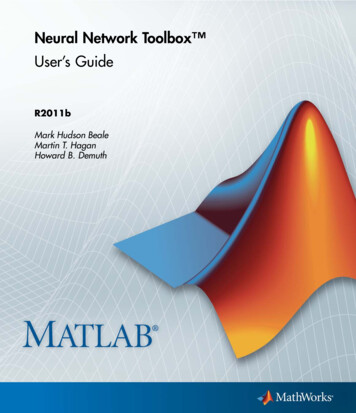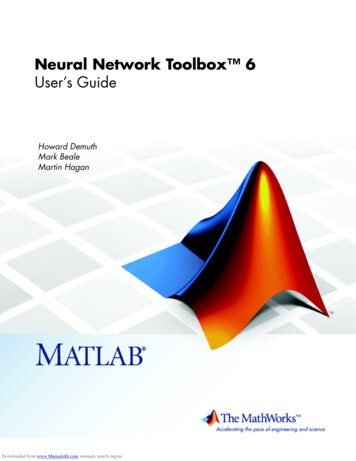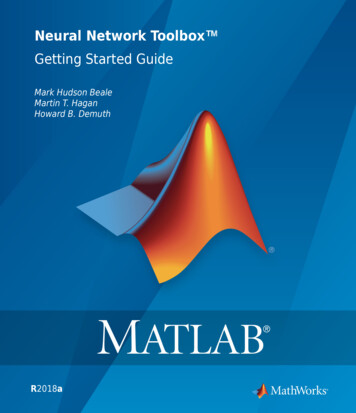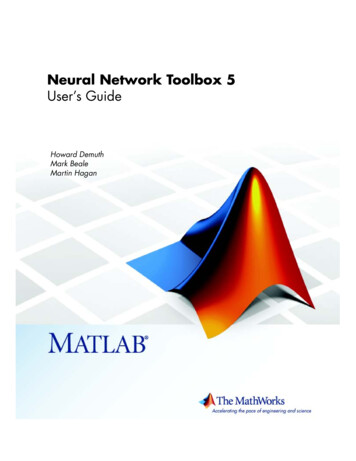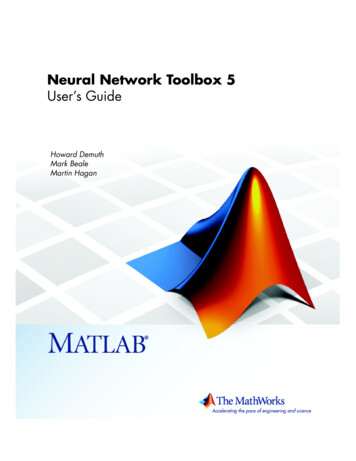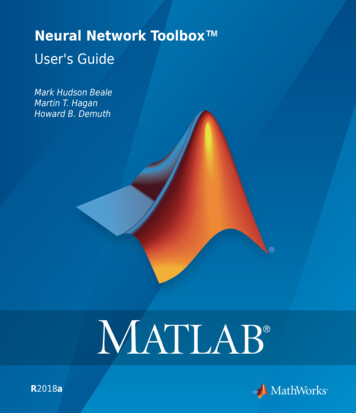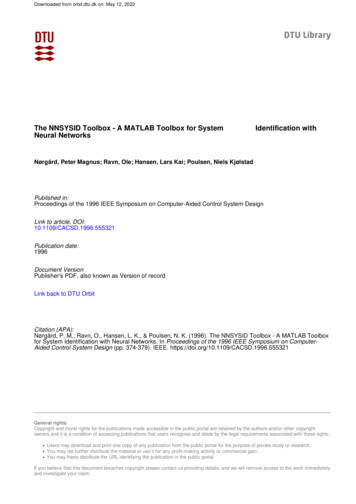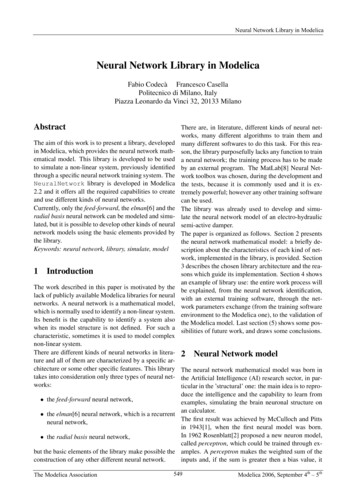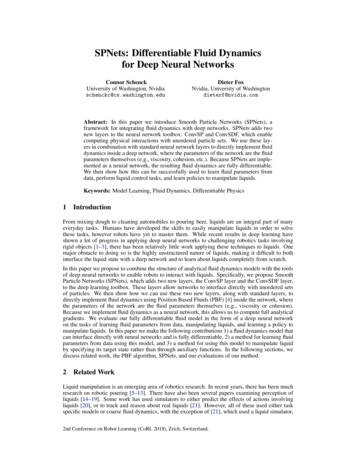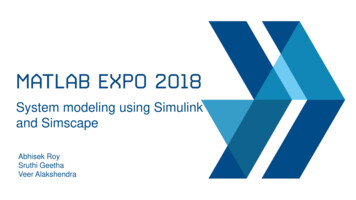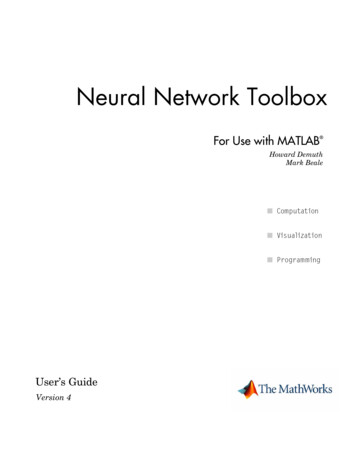
Transcription
Neural Network ToolboxFor Use with MATLAB Howard DemuthMark BealeUser’s GuideVersion 4
How to Contact The Newsgroup508-647-7000Technical supportProduct enhancement suggestionsBug reportsDocumentation error reportsOrder status, license renewals, passcodesSales, pricing, and general informationPhone508-647-7001FaxThe MathWorks, Inc.3 Apple Hill DriveNatick, MA athworks.cominfo@mathworks.comFor contact information about worldwide offices, see the MathWorks Web site.Neural Network Toolbox User’s Guide COPYRIGHT 1992 - 2004 by The MathWorks, Inc.The software described in this document is furnished under a license agreement. The software may be usedor copied only under the terms of the license agreement. No part of this manual may be photocopied orreproduced in any form without prior written consent from The MathWorks, Inc.FEDERAL ACQUISITION: This provision applies to all acquisitions of the Program and Documentation by,for, or through the federal government of the United States. By accepting delivery of the Program orDocumentation, the government hereby agrees that this software or documentation qualifies as commercialcomputer software or commercial computer software documentation as such terms are used or defined inFAR 12.212, DFARS Part 227.72, and DFARS 252.227-7014. Accordingly, the terms and conditions of thisAgreement and only those rights specified in this Agreement, shall pertain to and govern the use,modification, reproduction, release, performance, display, and disclosure of the Program and Documentationby the federal government (or other entity acquiring for or through the federal government) and shallsupersede any conflicting contractual terms or conditions. If this License fails to meet the government'sneeds or is inconsistent in any respect with federal procurement law, the government agrees to return theProgram and Documentation, unused, to The MathWorks, Inc.MATLAB, Simulink, Stateflow, Handle Graphics, and Real-Time Workshop are registered trademarks, andTargetBox is a trademark of The MathWorks, Inc.Other product or brand names are trademarks or registered trademarks of their respective holders.
History:June 1992April 1993January 1997July 1997January 1998September 2000June 2001July 2002January 2003June 2004October 2004First printingSecond printingThird printingFourth printingFifth printingSixth printingSeventh printingOnline onlyOnline onlyOnline onlyOnline onlyRevised for Version 3 (Release 11)Revised for Version 4 (Release 12)Minor revisions (Release 12.1)Minor revisions (Release 13)Minor revisions (Release 13SP1)Revised for Release 14Revised for Version 4.0.4 (Release 14SP1)
PrefaceNeural Networks (p. vi)Defines and introduces Neural NetworksBasic Chapters (p. viii)Identifies the chapters in the book with the basic,general knowledge needed to use the rest of the bookMathematical Notation for Equations andFigures (p. ix)Defines the mathematical notation used throughoutthe bookMathematics and Code Equivalents (p. xi)Provides simple rules for transforming equations tocode and visa versaNeural Network Design Book (p. xii)Gives ordering information for a useful supplementalbookAcknowledgments (p. xiii)Identifies and thanks people who helped make thisbook possible
PrefaceNeural NetworksNeural networks are composed of simple elements operating in parallel. Theseelements are inspired by biological nervous systems. As in nature, the networkfunction is determined largely by the connections between elements. We cantrain a neural network to perform a particular function by adjusting the valuesof the connections (weights) between elements.Commonly neural networks are adjusted, or trained, so that a particular inputleads to a specific target output. Such a situation is shown below. There, thenetwork is adjusted, based on a comparison of the output and the target, untilthe network output matches the target. Typically many such input/target pairsare used, in this supervised learning, to train a network.TargetInputNeural Networkincluding connections(called weights)between neuronsCompareOutputAdjustweightsBatch training of a network proceeds by making weight and bias changes basedon an entire set (batch) of input vectors. Incremental training changes theweights and biases of a network as needed after presentation of each individualinput vector. Incremental training is sometimes referred to as “on line” or“adaptive” training.Neural networks have been trained to perform complex functions in variousfields of application including pattern recognition, identification, classification,speech, vision and control systems. A list of applications is given in Chapter 1.Today neural networks can be trained to solve problems that are difficult forconventional computers or human beings. Throughout the toolbox emphasis isplaced on neural network paradigms that build up to or are themselves used inengineering, financial and other practical applications.vi
Neural NetworksThe supervised training methods are commonly used, but other networks canbe obtained from unsupervised training techniques or from direct designmethods. Unsupervised networks can be used, for instance, to identify groupsof data. Certain kinds of linear networks and Hopfield networks are designeddirectly. In summary, there are a variety of kinds of design and learningtechniques that enrich the choices that a user can make.The field of neural networks has a history of some five decades but has foundsolid application only in the past fifteen years, and the field is still developingrapidly. Thus, it is distinctly different from the fields of control systems oroptimization where the terminology, basic mathematics, and designprocedures have been firmly established and applied for many years. We do notview the Neural Network Toolbox as simply a summary of establishedprocedures that are known to work well. Rather, we hope that it will be a usefultool for industry, education and research, a tool that will help users find whatworks and what doesn’t, and a tool that will help develop and extend the fieldof neural networks. Because the field and the material are so new, this toolboxwill explain the procedures, tell how to apply them, and illustrate theirsuccesses and failures with examples. We believe that an understanding of theparadigms and their application is essential to the satisfactory and successfuluse of this toolbox, and that without such understanding user complaints andinquiries would bury us. So please be patient if we include a lot of explanatorymaterial. We hope that such material will be helpful to you.vii
PrefaceBasic ChaptersThe Neural Network Toolbox is written so that if you read Chapter 2, Chapter3 and Chapter 4 you can proceed to a later chapter, read it and use its functionswithout difficulty. To make this possible, Chapter 2 presents the fundamentalsof the neuron model, the architectures of neural networks. It also will discussnotation used in the architectures. All of this is basic material. It is to youradvantage to understand this Chapter 2 material thoroughly.The neuron model and the architecture of a neural network describe how anetwork transforms its input into an output. This transformation can beviewed as a computation. The model and the architecture each placelimitations on what a particular neural network can compute. The way anetwork computes its output must be understood before training methods forthe network can be explained.viii
Mathematical Notation for Equations and FiguresMathematical Notation for Equations and FiguresBasic ConceptsScalars-small italic letters.a,b,cVectors - small bold non-italic letters.a,b,cMatrices - capital BOLD non-italic letters.A,B,CLanguageVector means a column of numbers.Weight MatricesScalar Element w i, j ( t )i - row, j - column, t - time or iterationMatrix W ( t )Column Vector w j ( t )Row Vector iw ( t ) .vector made of ith row of weight matrix WBias VectorScalar Element b i ( t )Vector b ( t )Layer NotationA single superscript is used to identify elements of layer. For instance, the netinput of layer 3 would be shown as n3.Superscripts k, l are used to identify the source (l) connection and thedestination (k) connection of layer weight matrices ans input weight matrices.For instance, the layer weight matrix from layer 2 to layer 4 would be shownas LW4,2.ix
PrefaceInput Weight Matrix IWk, lLayer Weight Matrix LWk, lFigure and Equation ExamplesThe following figure, taken from Chapter 12 illustrates notation used in suchadvanced figures.Layers 1 and 2InputsLayer 3Outputsp1(k)IW1,12x14x2TDLn1(k)14x114x121 x (1*1)a1(k)b14LW3,3IW3,14x11x4a1(k) tansig (IW1,1p1(k) b1)1b31x1a2(k)TDL0,1IW2,13 x 33x1TDLn3(k)y1(k)3x1IW2,23 x (1*5)3a2(k) logsig (IW2,1 [p1(k);p1(k-1) ] IW2,2p2(k-1)) a3(k) purelin(LW3,3a3(k-1) IW3,1 a1 (k) b3 LW3,2a2 (k))x
Mathematics and Code EquivalentsMathematics and Code EquivalentsThe transition from mathematics to code or vice versa can be made with the aidof a few rules. They are listed here for future reference.To change from mathematics notation to MATLAB notation, the user needsto: Change superscripts to cell array indices.1For example, p p { 1 } Change subscripts to parentheses indices.1For example, p 2 p ( 2 ) , and p 2 p { 1 } ( 2 ) Change parentheses indices to a second cell array index.1For example, p ( k – 1 ) p { 1, k – 1 } Change mathematics operators to MATLAB operators and toolbox functions.For example, ab a*bThe following equations illustrate the notation used in figures.n w 1, 1 p 1 w 1, 2 p 2 . w 1, R p R bw 1, 1 w 1, 2 w 1, Rw 2, 1 w 2, 2 w 2, RW w S, 1 w S, 2 w S, Rxi
PrefaceNeural Network Design BookProfessor Martin Hagan of Oklahoma State University, and Neural NetworkToolbox authors Howard Demuth and Mark Beale have written a textbook,Neural Network Design (ISBN 0-9717321-0-8). The book presents the theory ofneural networks, discusses their design and application, and makesconsiderable use of MATLAB and the Neural Network Toolbox. Demonstrationprograms from the book are used in various chapters of this Guide. (You canfind all the book demonstration programs in the Neural Network Toolbox bytyping nnd.)The book has: An INSTRUCTOR’S MANUAL for adopters and TRANSPARENCY OVERHEADS for class use.This book can be obtained from the University of Colorado Bookstore at1-303-492-3648 or at the online purchase web site, cubooks.colorado.edu.To obtain a copy of the INSTRUCTOR’S MANUAL contact the University ofColorado Bookstore phone 1-303-492-3648. Ask specifically for an instructor’smanual if you are instructing a class and want one.You can go directly to the Neural Network Design page athttp://ee.okstate.edu/mhagan/nnd.htmlOnce there, you can download the TRANSPARENCY MASTERS with a clickon “Transparency Masters(3.6MB)”.You can get the Transparency Masters in Powerpoint or PDF format. You canobtain sample book chapters in PDF format as well.xii
AcknowledgmentsAcknowledgmentsThe authors would like to thank:Martin Hagan of Oklahoma State University for providing the originalLevenberg-Marquardt algorithm in the Neural Network Toolbox version 2.0and various algorithms found in version 3.0, including the new reducedmemory use version of the Levenberg-Marquardt algorithm, the conjugategradient algorithm, RPROP, and generalized regression method. Martin alsowrote Chapter 5 and Chapter 6 of this toolbox. Chapter 5 on Chapter describesnew algorithms, suggests algorithms for pre- and post-processing of data, andpresents a comparison of the efficacy of various algorithms. Chapter 6 oncontrol system applications describes practical applications including neuralnetwork model predictive control, model reference adaptive control, and afeedback linearization controller.Joe Hicklin of The MathWorks for getting Howard into neural networkresearch years ago at the University of Idaho, for encouraging Howard to writethe toolbox, for providing crucial help in getting the first toolbox version 1.0 outthe door, and for continuing to be a good friend.Jim Tung of The MathWorks for his long-term support for this project.Liz Callanan of The MathWorks for getting us off the such a good start withthe Neural Network Toolbox version 1.0.Roy Lurie of The MathWorks for his vigilant reviews of the developingmaterial in this version of the toolbox.Matthew Simoneau of The MathWorks for his help with demos, test suiteroutines, for getting user feedback, and for helping with other toolbox matters.Sean McCarthy for his many questions from users about the toolboxoperationJane Carmody of The MathWorks for editing help and for always being at herphone to help with documentation problems.Donna Sullivan and Peg Theriault of The MathWorks for their editing andother help with the Mac document.Jane Price of The MathWorks for getting constructive user feedback on thetoolbox document and its Graphical User’s Interface.xiii
PrefaceOrlando De Jesús of Oklahoma State University for his excellent work inprogramming the neural network controllers described in Chapter 6.Bernice Hewitt for her wise New Zealand counsel, encouragement, and tea,and for the company of her cats Tiny and Mr. Britches.Joan Pilgram for her business help, general support, and good cheer.Teri Beale for running the show and having Valerie and Asia Danielle whileMark worked on this toolbox.Martin Hagan and Howard Demuth for permission to include variousproblems, demonstrations, and other material from Neural Network Design,Jan. 1996.xiv
ContentsPrefaceNeural Networks . . . . . . . . . . . . . . . . . . . . . . . . . . . . . . . . . . . . . . viBasic Chapters . . . . . . . . . . . . . . . . . . . . . . . . . . . . . . . . . . . . . . . viiiMathematical Notation for Equations and Figures . . . . . . . . ixBasic Concepts . . . . . . . . . . . . . . . . . . . . . . . . . . . . . . . . . . . . . . . . ixLanguage . . . . . . . . . . . . . . . . . . . . . . . . . . . . . . . . . . . . . . . . . . . . ixWeight Matrices . . . . . . . . . . . . . . . . . . . . . . . . . . . . . . . . . . . . . . ixLayer Notation . . . . . . . . . . . . . . . . . . . . . . . . . . . . . . . . . . . . . . . . ixFigure and Equation Examples . . . . . . . . . . . . . . . . . . . . . . . . . . . xMathematics and Code Equivalents . . . . . . . . . . . . . . . . . . . . . xiNeural Network Design Book . . . . . . . . . . . . . . . . . . . . . . . . . . . xiiAcknowledgments . . . . . . . . . . . . . . . . . . . . . . . . . . . . . . . . . . . . xiiiIntroduction1Getting Started . . . . . . . . . . . . . . . . . . . . . . . . . . . . . . . . . . . . . . . 1-2Basic Chapters . . . . . . . . . . . . . . . . . . . . . . . . . . . . . . . . . . . . . . . 1-2Help and Installation . . . . . . . . . . . . . . . . . . . . . . . . . . . . . . . . . 1-2What’s New in Version 4.0 . . . . . . . . . . . . . . . . . . . . . . . . . . . . .Control System Applications . . . . . . . . . . . . . . . . . . . . . . . . . . .Graphical User Interface . . . . . . . . . . . . . . . . . . . . . . . . . . . . . .New Training Functions . . . . . . . . . . . . . . . . . . . . . . . . . . . . . . .Design of General Linear Networks . . . . . . . . . . . . . . . . . . . . . .Improved Early Stopping . . . . . . . . . . . . . . . . . . . . . . . . . . . . . .1-31-31-31-31-41-4xv
Generalization and Speed Benchmarks . . . . . . . . . . . . . . . . . . . 1-4Demonstration of a Sample Training Session . . . . . . . . . . . . . . 1-4Neural Network Applications . . . . . . . . . . . . . . . . . . . . . . . . . .Applications in this Toolbox . . . . . . . . . . . . . . . . . . . . . . . . . . . .Business Applications . . . . . . . . . . . . . . . . . . . . . . . . . . . . . . . . .Aerospace . . . . . . . . . . . . . . . . . . . . . . . . . . . . . . . . . . . . . . . . . . .Automotive . . . . . . . . . . . . . . . . . . . . . . . . . . . . . . . . . . . . . . . . . .Banking . . . . . . . . . . . . . . . . . . . . . . . . . . . . . . . . . . . . . . . . . . . .Credit Card Activity Checking . . . . . . . . . . . . . . . . . . . . . . . . . .Defense . . . . . . . . . . . . . . . . . . . . . . . . . . . . . . . . . . . . . . . . . . . . .Electronics . . . . . . . . . . . . . . . . . . . . . . . . . . . . . . . . . . . . . . . . . .Entertainment . . . . . . . . . . . . . . . . . . . . . . . . . . . . . . . . . . . . . . .Financial . . . . . . . . . . . . . . . . . . . . . . . . . . . . . . . . . . . . . . . . . . . .Industrial . . . . . . . . . . . . . . . . . . . . . . . . . . . . . . . . . . . . . . . . . . .Insurance . . . . . . . . . . . . . . . . . . . . . . . . . . . . . . . . . . . . . . . . . . .Manufacturing . . . . . . . . . . . . . . . . . . . . . . . . . . . . . . . . . . . . . . .Medical . . . . . . . . . . . . . . . . . . . . . . . . . . . . . . . . . . . . . . . . . . . . .Oil and Gas . . . . . . . . . . . . . . . . . . . . . . . . . . . . . . . . . . . . . . . . . .Robotics . . . . . . . . . . . . . . . . . . . . . . . . . . . . . . . . . . . . . . . . . . . . .Speech . . . . . . . . . . . . . . . . . . . . . . . . . . . . . . . . . . . . . . . . . . . . . .Securities . . . . . . . . . . . . . . . . . . . . . . . . . . . . . . . . . . . . . . . . . . .Telecommunications . . . . . . . . . . . . . . . . . . . . . . . . . . . . . . . . . .Transportation . . . . . . . . . . . . . . . . . . . . . . . . . . . . . . . . . . . . . . .Summary . . . . . . . . . . . . . . . . . . . . . . . . . . . . . . . . . . . . . . . . . . -71-71-71-71-71-7Neuron Model and Network Architectures2Neuron Model . . . . . . . . . . . . . . . . . . . . . . . . . . . . . . . . . . . . . . . .Simple Neuron . . . . . . . . . . . . . . . . . . . . . . . . . . . . . . . . . . . . . . .Transfer Functions . . . . . . . . . . . . . . . . . . . . . . . . . . . . . . . . . . . .Neuron with Vector Input . . . . . . . . . . . . . . . . . . . . . . . . . . . . . .2-22-22-32-5Network Architectures . . . . . . . . . . . . . . . . . . . . . . . . . . . . . . . . 2-8A Layer of Neurons . . . . . . . . . . . . . . . . . . . . . . . . . . . . . . . . . . . 2-8Multiple Layers of Neurons . . . . . . . . . . . . . . . . . . . . . . . . . . . . 2-11xvi Contents
Data Structures . . . . . . . . . . . . . . . . . . . . . . . . . . . . . . . . . . . . . .Simulation With Concurrent Inputs in a Static Network . . . .Simulation With Sequential Inputs in a Dynamic Network . .Simulation With Concurrent Inputs in a Dynamic Network .2-132-132-142-16Training Styles . . . . . . . . . . . . . . . . . . . . . . . . . . . . . . . . . . . . . . 2-18Incremental Training (of Adaptive and Other Networks) . . . . 2-18Batch Training . . . . . . . . . . . . . . . . . . . . . . . . . . . . . . . . . . . . . . 2-20Summary . . . . . . . . . . . . . . . . . . . . . . . . . . . . . . . . . . . . . . . . . . . . 2-24Figures and Equations . . . . . . . . . . . . . . . . . . . . . . . . . . . . . . . . 2-25Perceptrons3Introduction . . . . . . . . . . . . . . . . . . . . . . . . . . . . . . . . . . . . . . . . . . 3-2Important Perceptron Functions . . . . . . . . . . . . . . . . . . . . . . . . . 3-2Neuron Model . . . . . . . . . . . . . . . . . . . . . . . . . . . . . . . . . . . . . . . . 3-4Perceptron Architecture . . . . . . . . . . . . . . . . . . . . . . . . . . . . . . . 3-6Creating a Perceptron (newp) . . . . . . . . . . . . . . . . . . . . . . . . . . 3-7Simulation (sim) . . . . . . . . . . . . . . . . . . . . . . . . . . . . . . . . . . . . . . 3-8Initialization (init) . . . . . . . . . . . . . . . . . . . . . . . . . . . . . . . . . . . . 3-9Learning Rules . . . . . . . . . . . . . . . . . . . . . . . . . . . . . . . . . . . . . . 3-12Perceptron Learning Rule (learnp) . . . . . . . . . . . . . . . . . . . . 3-13Training (train) . . . . . . . . . . . . . . . . . . . . . . . . . . . . . . . . . . . . . . 3-16Limitations and Cautions . . . . . . . . . . . . . . . . . . . . . . . . . . . . . 3-21Outliers and the Normalized Perceptron Rule . . . . . . . . . . . . . 3-21Graphical User Interface . . . . . . . . . . . . . . . . . . . . . . . . . . . . . 3-23xvii
Introduction to the GUI . . . . . . . . . . . . . . . . . . . . . . . . . . . . . . .Create a Perceptron Network (nntool) . . . . . . . . . . . . . . . . . . .Train the Perceptron . . . . . . . . . . . . . . . . . . . . . . . . . . . . . . . . .Export Perceptron Results to Workspace . . . . . . . . . . . . . . . . .Clear Network/Data Window . . . . . . . . . . . . . . . . . . . . . . . . . .Importing from the Command Line . . . . . . . . . . . . . . . . . . . . .Save a Variable to a File and Load It Later . . . . . . . . . . . . . . .3-233-233-273-293-303-303-31Summary . . . . . . . . . . . . . . . . . . . . . . . . . . . . . . . . . . . . . . . . . . . . 3-33Figures and Equations . . . . . . . . . . . . . . . . . . . . . . . . . . . . . . . . 3-33New Functions . . . . . . . . . . . . . . . . . . . . . . . . . . . . . . . . . . . . . . 3-36Linear Filters4Introduction . . . . . . . . . . . . . . . . . . . . . . . . . . . . . . . . . . . . . . . . . . 4-2Neuron Model . . . . . . . . . . . . . . . . . . . . . . . . . . . . . . . . . . . . . . . . 4-3Network Architecture . . . . . . . . . . . . . . . . . . . . . . . . . . . . . . . . . 4-4Creating a Linear Neuron (newlin) . . . . . . . . . . . . . . . . . . . . . . . 4-4Mean Square Error . . . . . . . . . . . . . . . . . . . . . . . . . . . . . . . . . . . . 4-8Linear System Design (newlind) . . . . . . . . . . . . . . . . . . . . . . . . 4-9Linear Networks with Delays . . . . . . . . . . . . . . . . . . . . . . . . . 4-10Tapped Delay Line . . . . . . . . . . . . . . . . . . . . . . . . . . . . . . . . . . . 4-10Linear Filter . . . . . . . . . . . . . . . . . . . . . . . . . . . . . . . . . . . . . . . . 4-10LMS Algorithm (learnwh) . . . . . . . . . . . . . . . . . . . . . . . . . . . . . 4-13Linear Classification (train) . . . . . . . . . . . . . . . . . . . . . . . . . . 4-15Limitations and Cautions . . . . . . . . . . . . . . . . . . . . . . . . . . . . . 4-18Overdetermined Systems . . . . . . . . . . . . . . . . . . . . . . . . . . . . . . 4-18xviii Contents
Underdetermined Systems . . . . . . . . . . . . . . . . . . . . . . . . . . . . 4-18Linearly Dependent Vectors . . . . . . . . . . . . . . . . . . . . . . . . . . . 4-18Too Large a Learning Rate . . . . . . . . . . . . . . . . . . . . . . . . . . . . 4-19Summary . . . . . . . . . . . . . . . . . . . . . . . . . . . . . . . . . . . . . . . . . . . . 4-20Figures and Equations . . . . . . . . . . . . . . . . . . . . . . . . . . . . . . . . 4-21New Functions . . . . . . . . . . . . . . . . . . . . . . . . . . . . . . . . . . . . . . 4-25Backpropagation5Introduction . . . . . . . . . . . . . . . . . . . . . . . . . . . . . . . . . . . . . . . . . . 5-2Fundamentals . . . . . . . . . . . . . . . . . . . . . . . . . . . . . . . . . . . . . . . .Architecture . . . . . . . . . . . . . . . . . . . . . . . . . . . . . . . . . . . . . . . . .Simulation (sim) . . . . . . . . . . . . . . . . . . . . . . . . . . . . . . . . . . . . . .Training . . . . . . . . . . . . . . . . . . . . . . . . . . . . . . . . . . . . . . . . . . . .5-45-45-85-8Faster Training . . . . . . . . . . . . . . . . . . . . . . . . . . . . . . . . . . . . . .Variable Learning Rate (traingda, traingdx) . . . . . . . . . . . . . .Resilient Backpropagation (trainrp) . . . . . . . . . . . . . . . . . . . . .Conjugate Gradient Algorithms . . . . . . . . . . . . . . . . . . . . . . . .Line Search Routines . . . . . . . . . . . . . . . . . . . . . . . . . . . . . . . . .Quasi-Newton Algorithms . . . . . . . . . . . . . . . . . . . . . . . . . . . . .Levenberg-Marquardt (trainlm) . . . . . . . . . . . . . . . . . . . . . . . .Reduced Memory Levenberg-Marquardt (trainlm) . . . . . . . . .5-145-145-165-175-235-265-285-30Speed and Memory Comparison . . . . . . . . . . . . . . . . . . . . . . . 5-32Summary . . . . . . . . . . . . . . . . . . . . . . . . . . . . . . . . . . . . . . . . . . 5-49Improving Generalization . . . . . . . . . . . . . . . . . . . . . . . . . . . .Regularization . . . . . . . . . . . . . . . . . . . . . . . . . . . . . . . . . . . . . .Early Stopping . . . . . . . . . . . . . . . . . . . . . . . . . . . . . . . . . . . . . .Summary and Discussion . . . . . . . . . . . . . . . . . . . . . . . . . . . . .5-515-525-555-57Preprocessing and Postprocessing . . . . . . . . . . . . . . . . . . . . . 5-61Min and Max (premnmx, postmnmx, tramnmx) . . . . . . . . . . . 5-61xix
Mean and Stand. Dev. (prestd, poststd, trastd) . . . . . . . . . . . . 5-62Principal Component Analysis (prepca, trapca) . . . . . . . . . . . . 5-63Post-Training Analysis (postreg) . . . . . . . . . . . . . . . . . . . . . . . . 5-64Sample Training Session . . . . . . . . . . . . . . . . . . . . . . . . . . . . . . 5-66Limitations and Cautions . . . . . . . . . . . . . . . . . . . . . . . . . . . . . 5-71Summary . . . . . . . . . . . . . . . . . . . . . . . . . . . . . . . . . . . . . . . . . . . . 5-73Control Systems6Introduction . . . . . . . . . . . . . . . . . . . . . . . . . . . . . . . . . . . . . . . . . . 6-2NN Predictive Control . . . . . . . . . . . . . . . . . . . . . . . . . . . . . . . . .System Identification . . . . . . . . . . . . . . . . . . . . . . . . . . . . . . . . . .Predictive Control . . . . . . . . . . . . . . . . . . . . . . . . . . . . . . . . . . . .Using the NN Predictive Controller Block . . . . . . . . . . . . . . . . .6-46-46-56-6NARMA-L2 (Feedback Linearization) Control . . . . . . . . . .Identification of the NARMA-L2 Model . . . . . . . . . . . . . . . . . .NARMA-L2 Controller . . . . . . . . . . . . . . . . . . . . . . . . . . . . . . . .Using the NARMA-L2 Controller Block . . . . . . . . . . . . . . . . . .6-146-146-166-18Model Reference Control . . . . . . . . . . . . . . . . . . . . . . . . . . . . . 6-23Using the Model Reference Controller Block . . . . . . . . . . . . . . 6-25Importing and Exporting . . . . . . . . . . . . . . . . . . . . . . . . . . . . . 6-31Importing and Exporting Networks . . . . . . . . . . . . . . . . . . . . . 6-31Importing and Exporting Training Data . . . . . . . . . . . . . . . . . 6-35Summary . . . . . . . . . . . . . . . . . . . . . . . . . . . . . . . . . . . . . . . . . . . . 6-38xxContents
Radial Basis Networks7Introduction . . . . . . . . . . . . . . . . . . . . . . . . . . . . . . . . . . . . . . . . . . 7-2Important Radial Basis Functions . . . . . . . . . . . . . . . . . . . . . . . 7-2Radial Basis Functions . . . . . . . . . . . . . . . . . . . . . . . . . . . . . . . .Neuron Model . . . . . . . . . . . . . . . . . . . . . . . . . . . . . . . . . . . . . . . .Network Architecture . . . . . . . . . . . . . . . . . . . . . . . . . . . . . . . . .Exact Design (newrbe) . . . . . . . . . . . . . . . . . . . . . . . . . . . . . . . . .More Efficient Design (newrb) . . . . . . . . . . . . . . . . . . . . . . . . . .Demonstrations . . . . . . . . . . . . . . . . . . . . . . . . . . . . . . . . . . . . . .7-37-37-47-57-77-8Generalized Regression Networks . . . . . . . . . . . . . . . . . . . . . . 7-9Network Architecture . . . . . . . . . . . . . . . . . . . . . . . . . . . . . . . . . 7-9Design (newgrnn) . . . . . . . . . . . . . . . . . . . . . . . . . . . . . . . . . . . . 7-10Probabilistic Neural Networks . . . . . . . . . . . . . . . . . . . . . . . . 7-12Network Architecture . . . . . . . . . . . . . . . . . . . . . . . . . . . . . . . . 7-12Design (newpnn) . . . . . . . . . . . . . . . . . . . . . . . . . . . . . . . . . . . . 7-13Summary . . . . . . . . . . . . . . . . . . . . . . . . . . . . . . . . . . . . . . . . . . . . 7-15Figures . . . . . . . . . . . . . . . . . . . . . . . . . . . . . . . . . . . . . . . . . . . . 7-16New Functions . . . . . . . . . . . . . . . . . . . . . . . . . . . . . . . . . . . . . . 7-18Self-Organizing and Learn. Vector Quant. Nets8Introduction . . . . . . . . . . . . . . . . . . . . . . . . . . . . . . . . . . . . . . . . . . 8-2Important Self-Organizing and LVQ Functions . . . . . . . . . . . . . 8-2Competitive Learning . . . . . . . . . . . . . . . . . . . . . . . . . . . . . . . . .Architecture . . . . . . . . . . . . . . . . . . . . . . . . . . . . . . . . . . . . . . . . .Creating a Competitive Neural Network (newc) . . . . . . . . . . . .Kohonen Learning Rule (learnk) . . . . . . . . . . . . . . . . . . . . . . . . .Bias Learning Rule (learncon) . . . . . . . . . . . . . . . . . . . . . . . . . . .Training . . . . . . . . . . . . . . . . . . . . . . . . . . . . . . . . . . . . . . . . . . . .8-38-38-48-58-58-6xxi
Graphical Example . . . . . . . . . . . . . . . . . . . . . . . . . . . . . . . . . . . 8-7Self-Organizing Maps . . . . . . . . . . . . . . . . . . . . . . . . . . . . . . . . . . 8-9Topologies (gridtop, hextop, randtop) . . . . . . . . . . . . . . . . . . . . 8-10Distance Funct. (dist, linkdist, mandist, boxdist) . . . . . . . . . . 8-14Architecture . . . . . . . . . . . . . . . . . . . . . . . . . . . . . . . . . . . . . . . . 8-17Creating a Self Organizing MAP Neural Network (newsom) . 8-18Training (learnsom) . . . . . . . . . . . . . . . . . . . . . . . . . . . . . . . . . . 8-19Examples . . . . . . . . . . . . . . . . . . . . . . . . . . . . . . . . . . . . . . . . . . 8-23Learning Vector Quantization Networks . . . . . . . . . . . . . . .Architecture . . . . . . . . . . . . . . . . . . . . . . . . . . . . . . . . . . . . . . . .Creating an LVQ Network (newlvq) . . . . . . . . . . . . . . . . . . . . .LVQ1 Learning Rule (learnlv1) . . . . . . . . . . . . . . . . . . . . . . . . .Training . . . . . . . . . .
The Neural Network Toolbox is written so that if you read Chapter 2, Chapter 3 and Chapter 4 you can proceed to a later chapter, read it and use its functions without difficulty. To make this possibl e, Chapter 2 presents the fundamentals of the neuron model, the architectures of neural networks. It also will discuss
